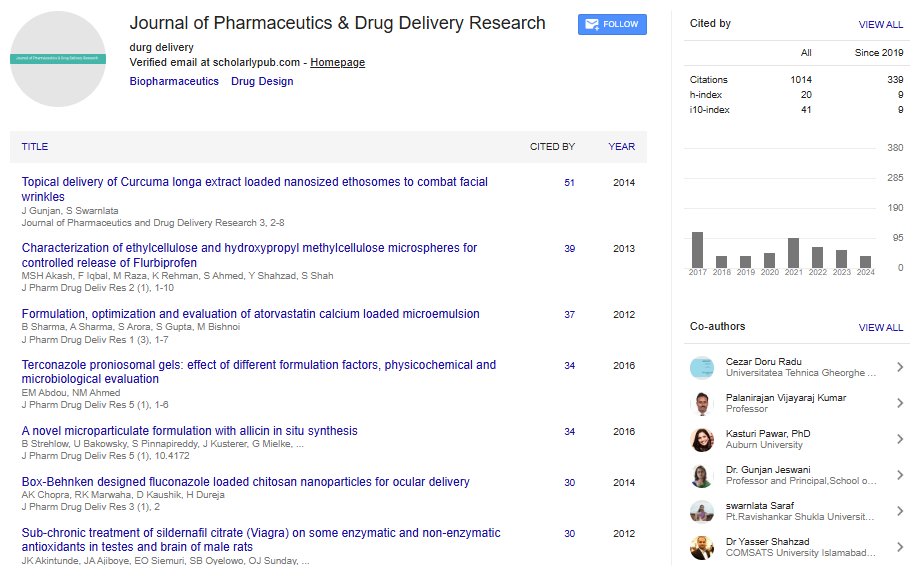Opinion Article, J Pharm Drug Deliv Res Vol: 13 Issue: 4
An Extensive Guide to Comprehending Drug Side Effects
Gillian Kolla*
1Department of Pharmacology, Shanghai Jiao Tong University School of Medicine, Shanghai, China
*Corresponding Author: Gillian Kolla,
Department of Pharmacology, Shanghai Jiao
Tong University School of Medicine, Shanghai, China
E-mail: kollag57@gmail.com
Received date: 01 July, 2024, Manuscript No. JPDDR-24-145762;
Editor assigned date: 03 July, 2024, PreQC No. JPDDR-24-145762 (PQ);
Reviewed date: 17 July, 2024, QC No. JPDDR-24-145762;
Revised date: 24 July, 2024, Manuscript No. JPDDR-24-145762 (R);
Published date: 31 July, 2024, DOI: 10.4172/2325-9604.1000291
Citation: Kolla G (2024) An Extensive Guide to Comprehending Drug Side Effects. J Pharm Drug Deliv Res 13:4.
Description
Drug side effects are an inherent part of pharmacotherapy. While medications are designed to alleviate symptoms, treat diseases, or manage chronic conditions, they can also produce unintended and sometimes adverse effects. Understanding these side effects is essential for both healthcare professionals and patients to ensure safe and effective use of medications.
Drug side effects, also known as Adverse Drug Reactions (ADRs), are unintended and often undesirable effects that occur in addition to the intended therapeutic effects of a medication. These effects can range from mild, such as a headache or nausea, to severe, such as lifethreatening allergic reactions or organ damage. The occurrence and severity of side effects depend on various factors, including the drug’s mechanism of action, dosage, duration of use and individual patient characteristics such as age, gender, genetic makeup and overall health.
Types of drug side effects
Dose-related side effects: These occur when a drug’s concentration in the bloodstream reaches a level that produces toxic effects. For example, taking too much acetaminophen can lead to liver damage. Dose-related side effects are often predictable and can be managed by adjusting the dosage or frequency of administration.
Allergic reactions: These are immune system responses to a drug, ranging from mild skin rashes to severe anaphylaxis, which can be life-threatening. Penicillin, for example, is known to cause allergic reactions in some individuals. It’s essential for patients to inform healthcare providers about any known allergies to avoid these reactions.
Idiosyncratic reactions: These are unpredictable side effects that do not depend on the dose and occur due to genetic or unknown factors. For instance, some individuals may experience severe reactions to certain drugs, such as agranulocytosis (a dangerous drop in white blood cells) caused by clozapine, an antipsychotic medication.
Long-term effects: Prolonged use of certain drugs can lead to chronic side effects. For example, long-term use of corticosteroids can result in osteoporosis, cataracts and increased susceptibility to infections. Monitoring and managing these effects require careful consideration of the risk-benefit ratio, especially for patients requiring long-term therapy.
Factors influencing drug side effects
Several factors contribute to the likelihood and severity of drug side effects:
Patient-specific factors: Age, gender, body weight and genetic factors can all influence how a drug is metabolized and the likelihood of side effects. For instance, elderly patients may be more susceptible to side effects due to slower metabolism and the presence of multiple comorbidities.
Drug-drug interactions: Taking multiple medications can increase the risk of side effects due to interactions between drugs. For example, combining blood thinners like warfarin with Nonsteroidal Anti- Inflammatory Drugs (NSAIDs) can increase the risk of bleeding.
Drug-food interactions: Certain foods can interact with drugs, affecting their absorption and metabolism. For instance, grapefruit juice can interfere with the metabolism of certain medications, leading to higher blood levels and an increased risk of side effects.
Dosage and duration of use: Higher doses and prolonged use of a medication increase the likelihood of side effects. For example, using high doses of opioids for an extended period can lead to dependence and respiratory depression.
Minimizing and managing drug side effects
Patient education: Educating patients about potential side effects and how to recognize them is essential. Patients should be encouraged to report any unusual symptoms to their healthcare provider promptly.
Regular monitoring: Healthcare providers should regularly monitor patients, especially those on long-term or high-risk medications, for signs of adverse effects. This may include blood tests, liver and kidney function tests and monitoring for changes in vital signs.
Adjusting therapy: If side effects are significant, healthcare providers may adjust the dosage, switch to an alternative medication, or implement supportive measures to manage symptoms.
Pharmacovigilance: Ongoing surveillance and reporting of adverse drug reactions through pharmacovigilance programs help in identifying new side effects, especially for newly marketed drugs. This information is essential for updating prescribing information and improving patient safety.
Conclusion
Drug side effects is a precarious aspect of medication management. By recognizing the types of side effects, factors that influence their occurrence and strategies for minimizing and managing them, healthcare providers can enhance patient safety and therapeutic outcomes. Patients, too, play a vital role in this process by staying informed, adhering to prescribed treatments and communicating openly with their healthcare team about any concerns or adverse effects they experience. Through collaborative efforts, the risks associated with drug side effects can be effectively mitigated, ensuring that the benefits of medications outweigh the potential harms.
 Spanish
Spanish  Chinese
Chinese  Russian
Russian  German
German  French
French  Japanese
Japanese  Portuguese
Portuguese  Hindi
Hindi 
